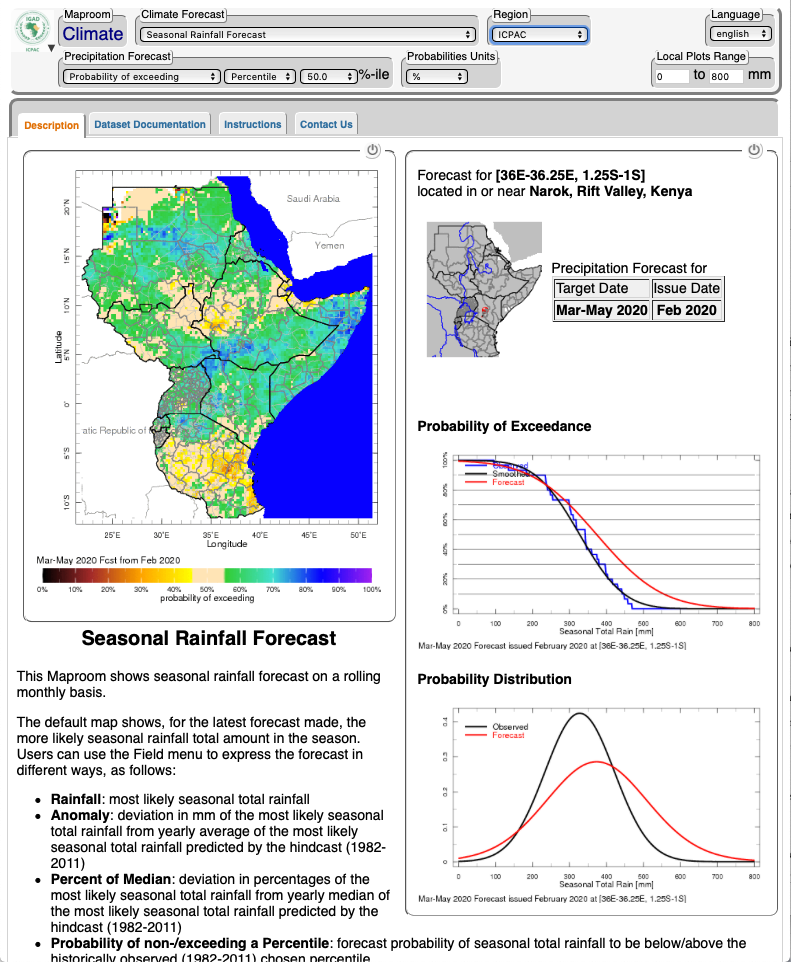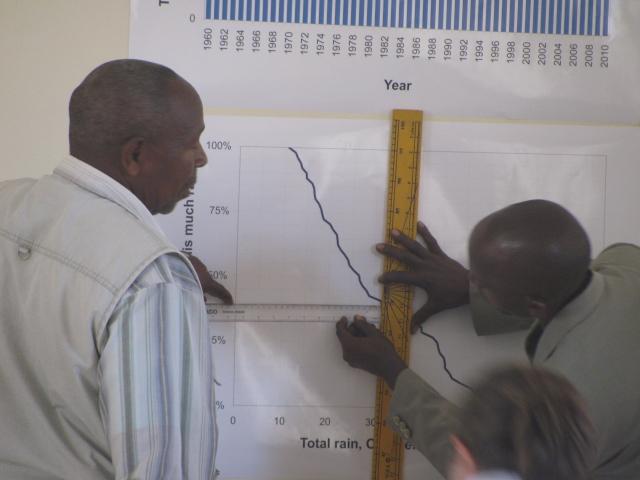A new seasonal climate forecast system supports East African agriculture
Improved forecast presentation solves key gaps in the usability of the widely used tercile seasonal forecast convention for farmer decision-making.
In 1997-1998, Regional Climate Outlook Forums (RCOFs) were established throughout Africa to reduce drought impacts on smallholder agriculture. However, gaps between farmers’ needs and how RCOF seasonal forecasts are presented have limited their usability.
The Regional Climate Centre responsible for Eastern Africa, the GAD Climate Prediction and Applications Centre (ICPAC), has introduced a new forecast system that largely overcomes the longstanding obstacles to using seasonal forecasts for local agricultural decision-making.
ROOTS OF SEASONAL CLIMATE FORECASTS IN AFRICA
The Greater Horn of Africa Regional Climate Outlook Forum (GHACOF) is one of about 20 RCOFs in operation globally. Most of the RCOFs, like most developing-country National Meteorological Services (NMS), still use the same approach to creating the forecasts that they adopted when they were established.
Their approach bases a seasonal forecast on a consensus that is negotiated by participating meteorologists. The forecast is then presented as a coarse-scale map showing the probability that upcoming rainfall will fall in the driest, middle and wettest thirds (or terciles) of past years—described as “below-normal,” “normal” or “above-normal” categories.
The NMS are charged with downscaling these forecasts and tailoring them to user needs. However, in practice, they are often collapsed into statements about the most likely categories, for example, “rainfall will be normal to above-normal,” by the time they reach the general public.
Experience accumulated across a range of contexts soon revealed that these conventional forecasts were missing crucial information that farmers need to plan for the upcoming growing season, including:
- what the forecast means for weather conditions in her farm’s location;
- how the forecast affects the likelihood of experiencing above or below threshold rainfall amounts relevant to her decisions;
- characteristics of growing season rainfall, beyond the 3-month total, that impact her farming system; and
- the degree of accuracy, or conversely the uncertainty, of the forecast.
A NEW GENERATION OF REGIONAL SEASONAL CLIMATE FORECASTS
ICPAC is a Regional Climate Centre, based in Nairobi, that aims to build the resilience of 11 member countries in East Africa to the region’s climate. ICPAC also organizes GHACOF three times a year. In 2019, ICPAC launched a new seasonal forecast system, as part of its commitment to improving regional climate forecasts and the forecasting capacity of member countries.
The new system combines the output of the best available climate models to improve the quality of the seasonal forecast for the region. Instead of basing the forecast on a subjective consensus among meteorologists, it uses objective statistical methods to find the best consensus among the climate prediction models.
As such, ICPAC was the first regional climate centre in Africa to follow the World Meteorological Organization’s (WMO) 2017 recommendation to switch to seasonal forecast methods that are objective, traceable and reproducible.
This new generation of seasonal climate forecasts is a result of a long-term partnership among ICPAC, the CGIAR Research Program on Climate Change, Agriculture and Food Security (CCAFS), the International Research Institute for Climate and Society (IRI) and the UK’s Met Office, supported in part by the UK and U.S. governments.
Changing the way forecasts are produced and presented in GHACOF involved years of repeated communication, including significant side meetings that CCAFS co-organized at the 44th (August 2016) and 48th GHACOF sessions, and most recently the Agriculture and Food Security co-production session of the 57th GHACOF (February 2021).

A screenshot of the ICPAC Maproom
A TRANSFORMATIVE FORECAST PRESENTATION FOR AGRICULTURE
Although the WMO recommendation was meant to improve forecast quality, the major breakthrough from an agricultural perspective is the improved way of presenting the forecasts that solves the main weaknesses of the tercile convention.
For regional agricultural and food security decision makers, ICPAC’s Seasonal Rainfall Forecast “Maproom” opens with a map view that provides several options for viewing the downscaled forecast in space. A local decision maker can access downscaled forecast information by selecting their grid cell location.
By replacing the tercile categories with a full forecast probability distribution, the forecast shows the likelihood of experiencing seasonal rainfall above or below any decision-relevant threshold.

Two participants examine a graph with a ruler at a farmer training workshop in Wote, Kenya in September 2011. © J. Hansen (CCAFS)
Presenting the forecast distribution alongside the local historical distribution helps users to relate the forecast to their experience with climate variability—with the added benefit of building awareness of past behaviour of their local climate.
It also shows how the forecast shifts the likelihood that seasonal rainfall will be above or below any relevant threshold. The shape of the forecast distribution, and time-series graphs of past forecast performance, help convey the accuracy of forecasts.
FROM THE REGION TO NATIONS TO THE FARMER
ICPAC plays a major role in strengthening the capacity of National Meteorological Services, which are the primary source of weather and climate information for agricultural decision makers from farm to national levels.
The NMS of Rwanda and Ethiopia have already implemented similar objective seasonal forecast systems and improved forecast presentation, built on high-quality national gridded data sets and made available through online Maprooms. With technical support from ICPAC and IRI, Kenya’s NMS is preparing to launch their improved seasonal forecast system and Maproom.
Farmers can best take advantage of the new forecasts when they are bundled with a training and planning workshop. Probabilistic forecasts can be challenging to understand. And yet, our experience in several African countries show that farmers can understand and use forecasts presented in this way, and prefer them, once they have been introduced to them in a workshop process that follows a logical progression from their memory of past variability to probability graphs.
Our experience with ICPAC demonstrates how the work of a strong Regional Climate Centre can transform the way climate information is provided across multiple countries. And our experience in Rwanda demonstrates how a strong agricultural extension system can empower farmers to benefit from that information—at scale.
***
The CGIAR Research Program on Climate Change, Agriculture and Food Security (CCAFS) supported the development of the new forecast products and other online Maproom tools for agriculture through the Climate Services for Africa project funded by the U.S. Agency for International Development (USAID), in coordination with efforts by two projects of the Weather and Climate Information Services for Africa (WISER) program, funded by the UK Foreign, Commonwealth & Development Office (FCDO, formerly Department for International Development (DfID)): Strengthening Climate Information Partnerships – East Africa (SCIPEA), and Enhancing National Climate Services (ENACTS). Subsequent financial and technical support to develop the improved regional forecast system came through WISER Support to ICPAC (WISER-W2SIP), the African Science for Weather Information and Forecasting Techniques (African SWIFT) project funded by the Global Challenges Research Fund, and the Science for Humanitarian Emergencies and Resilience: Probabilistic Forecast Information for Defensible (SHEAR-ForPAc) project co-funded by FCDO and Natural Environmental Research Council (NERC). The International Research Institute for Climate and Society (IRI) developed the NextGen seasonal forecast tools and Flexible Forecast Maproom presentation that ICPAC and the NMS of Rwanda and Ethiopia adopted.